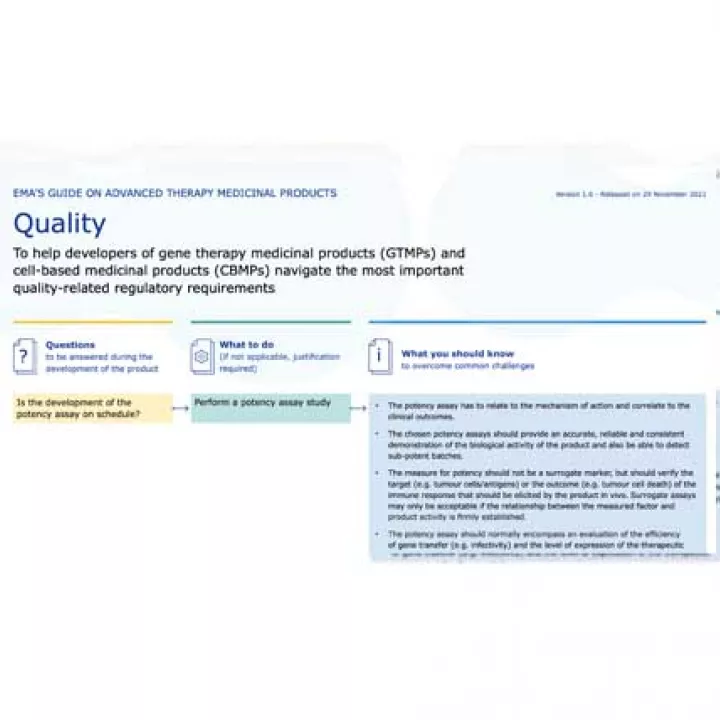Advanced therapy medicinal products (ATMP) manufacturing concerns the industry-scale production of these therapies for supporting clinical development and commercialisation. This section provides an overview of the ATMP manufacturing processes, key terms, and related resources.
Advanced therapy medicinal products (ATMP) manufacturing refers to the scale-up or scale-out steps to provide the increasing demand of doses required for clinical trials and commercialisation at the industrial scale. Scale-up typically is for increasing the manufacturing capacity by increasing the number of cells or volume for each lot, whereas scale-out is for running multiple smaller operation units in parallel.
Manufacturing processes for ATMPs vary in complexity. At a high level, gene therapy is manufactured using a process similar to other biological products, such as protein drugs and vaccines. It starts with a small cell culture of the host cells, and the culture is expanded and scaled to a series of larger batches until the desired number of host cells is reached. The host cells are then transfected with plasmid DNA encoding the necessary proteins for viral production, harvested, and lysed to release the viral vectors. Viral vectors are subsequently purified and tested for its function, and are formulated and packaged for clinical use. Read more about these processes at: Clinical use of lentiviral vectors and Overcoming Bottlenecks in AAV Manufacturing for Gene Therapy.
Cell therapy manufacturing starts with the collection of cells from a patient or a donor. After isolation, in vitro manipulations and expansion at the manufacturing site, the cells are returned to the same patient (autologous) or many other patients (allogeneic). Due to its nature, autologous cell therapies are mostly produced at a small scale in dedicated manufacturing facilities in proximity to the patient’s point-of-care. Allogeneic cell therapies, however, can be manufactured in batches, and the process development leverages existing bioprocessing technologies for manufacturing biological products. Therapeutic cells are expanded in large scale bioreactors and banked by cryopreservation for greater production volumes at a reduced therapy cost.
Quality plays a critical role in the safety and efficacy profile of ATMPs. To ensure the quality of the ATMP, in-process quality control assays are coupled with the manufacturing process, and quality release testing criteria need to be met.

The European Medicines Agency created a flow chart to help navigate the most important quality-related regulatory requirements.
The Good Manufacturing Practices (GMP) compliance ensures that products are consistently produced based on quality standards. However, the manufacturing of ATMPs presents unique quality challenges. ATMPs are complex products and risks may arise during manufacturing according to the type of product, nature of the starting materials, and the manufacturing process. The finished product may contain some degrees of variability due to the use of biological materials (e.g., living materials that interacts with the human body) or complex manipulation (e.g., altering the function of the cells). Therefore, it is necessary to provide a certain level of flexibility to take into account these specific challenges when setting the GMP requirements for ATMPs.
The recognition of these unique challenges has led to specific guidelines on GMP for ATMPs. You can find these ATMP-specific GMP Guidelines on the European Commission page here alongside a helpful Question & Answer Guide from the European Medicines Agency. The ATMP-specific GMP guidelines are adapted from the EU GMP requirements to accommodate the complexity of ATMPs and their manufacturing scenarios. A risk-based approach (see page 8) can be used for the manufacturer to design the organisational, technical, and structural measures to provide flexibility, and at the same time, to ensure a high "pharmaceutical quality system" that safeguards the quality of the ATMP.
Additional challenges in ATMP manufacturing include: the necessity of maintaining sterility throughout the entire manufacturing process, the need for continuous monitoring and controls, the complexity of the manufacturing process, the short product shelf life, and the high production cost. New manufacturing methodologies such as automation, closed systems, process analytics, and decentralised manufacturing are being developed and implemented to address these challenges.
Acknowledgements
Published: 29/01/2022
Author:
Hsin-Yu Kuo, EuroGCT Project Manager - Research Information and Networks
Reviewed by:
Aurélie Mahalatchimy, EuroGCT WP4 Convenor, UMR 7318 DICE CERIC, Aix-Marseille University, CNRS, Aix-en-Provence- France


